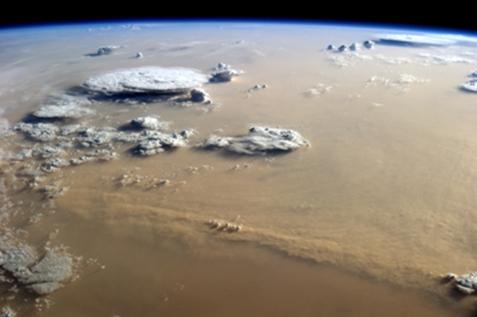[2016] The past, present and future of African dust
So much dust is scattered across the planet by the winds of the Sahara that it alters the climate. However, the emission and transport of this dust, which can reach the poles, fluctuate considerably. Although many hypotheses have been put forward to explain this phenomenon, no unambiguous relationship between this dust and the climate had been established until now. According to research carried out by a French-US team of researchers from LATMOS1(CNRS/UVSQ/UPMC), CNRM2(CNRS/Météo-France) and SIO3, meteorological events such as El Niño and rainfall in the Sahel have an impact on dust emission, by accelerating a Saharan wind downstream of the main mountain massifs of Northwest Africa. The scientists have also developed a new predictive model showing that emissions of Saharan dust will decline over the next hundred years. Their work is published in the 24 March 2016 issue of the journal Nature.
The Sahara desert emits more dust than any other desert in the world. More than half of the dust deposited in the oceans originates in North Africa. This Saharan dust affects the climate: among other things, it contains nutrients that fertilize both land and water, it blocks or reflects sunlight, and it affects the formation of clouds and hurricanes. The dust consists mainly of aerosols measuring between 0.1 and 20 microns, which remain windborne until they are deposited by their weight or by rainfall. Emission and dispersion of the dust is affected by a number of meteorological phenomena, such as El Niño, the North Atlantic Oscillation, rainfall in the Sahel, the Sahara Heat Low, and the Intertropical Convergence Zone. They depend in particular on the strength of a Saharan wind called the Harmattan, which accelerates when it blows across the mountain massifs of Northwest Africa4. If its speed is high enough and it blows over dust source regions, it lifts the dust and disperses it.
In order to elucidate these complex relationships, the researchers carried out a statistical analysis of reconstructed twentieth-century data of winds ten meters above the surface, which is the meteorological standard. Combined with the study of dust deposits in the coral reefs of Cape Verde, the wind data were used to estimate fluctuations in dust emissions since the 1850s. The results obtained reproduce several well-known events, showing that the North Atlantic Oscillation caused important dust emissions in the years 1910-1940, as did the Sahel drought of the 1980s. Moreover, the researchers showed that in North Africa, the regions where the Harmattan is preferentially accelerated are located over dust source regions. According to them, the meteorological phenomena mentioned above are able to modify the intensity of the Harmattan, and hence of Saharan dust emissions, over time scales ranging from a few days to several years.
Since this method successfully reproduced past events, it was then applied to future climate projections with the aim of establishing trends until the end of the twenty-first century. The method predicts a decrease in dust generation. Although this could have beneficial effects on the health of human populations, it might also increase warming of the tropical North Atlantic, making it more suitable for hurricane formation and growth.
Reference: Evan, A.T., Flamant, C., Gaetani, M., and Guichard, F. (2016). The past, present and future of African dust. Nature 531, 493.
Press release: http://www2.cnrs.fr/en/2733.htm
Figure: Image taken from the International Space Station over Libya looking in a south-south-westerly direction, showing a dust storm stretching several hundred kilometers across the Sahara. Isolated cumulonimbus clouds are developing within the dust layer. (c) NASA / ISS - Digital Camera

